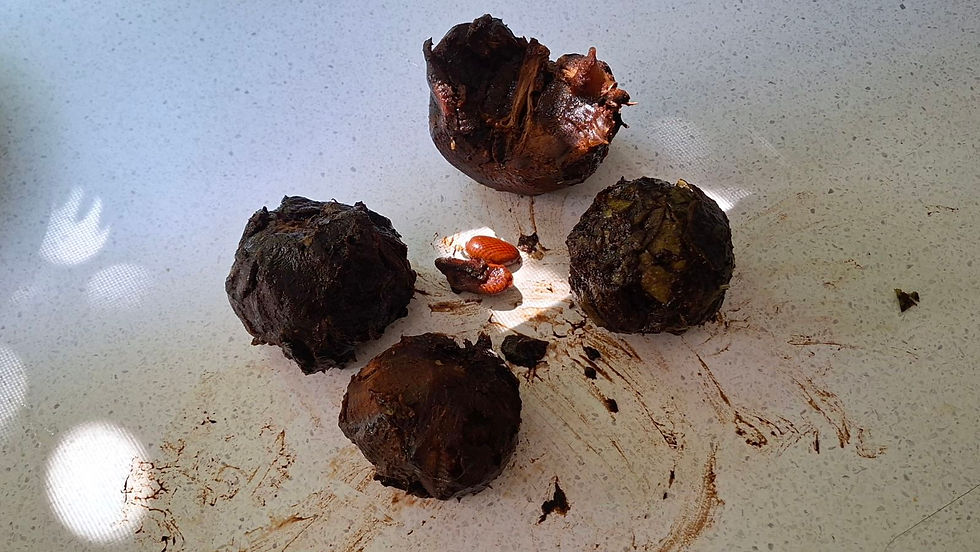Julie Anderson talks with Ed Reither #5
- "Evelyn" exposed

- Jul 28, 2023
- 5 min read
Updated: Jul 30, 2023
Link to Julie and Ed talking
Link to info re Albert Hoffman
Link to description of the Perfect Practice
Link to What is ‘Practice’?
The heart has a question.
The heart must be Satisfied.
Without that Satisfaction – Which is necessarily Spiritual in Nature – there is no Real Happiness.
You cannot be sane if you think there is only flesh, only materiality, only grossness.
Such thinking is not fully "natural" enough.
There is "Something" you are not accounting for.
Be open to "Whatever" That Is.
It is not enough to merely go on presuming the materialist disposition.
You must look into this.
— Avatar Adi Da Samraj Hridaya Rosary
From The Knee Of Listening (Adi Da Samraj)
"By Means of My Own Avataric Ordeal of Divine Re-Awakening,
I have Demonstrated, Revealed, Exemplified, and Proven that
neither the fifth stage Emanationist mode of Realization (which
is founded on the Vertical dimension, or the extended psycho-
physical pattern, of the functional and experiential human body-
mind) nor the sixth stage non-Emanationist (or Transcendentalist)
mode of Realization (which is founded on the Horizontal dimen-
sion, or the hierarchical heart-pattern, at the core and root of the
human body-mind) Is the Most Perfect (and Most Perfectly ego-
Transcending) Realization of the Divine (or One, and Only, and
Perfectly Subjective) Reality, Truth, Source-Condition, and Self-
Condition of all-and-All—but only the only-by-Me Revealed and
Given seventh stage Realization (Which is founded on the
Inseparable Unity of the Horizontal and the Vertical dimensions of
the human body-mind, and on the Inherent Non-“Difference”
between the conditional and the Unconditional dimensions of
Reality Itself) Is Divine Self-Realization Itself (and the Completion,
and the Perfect Transcending, of all six of the previous stages
of life).
The apparent (and conventionally presumed, and psycho-
physically based) distinction between the Devotional and Spiritual
practice (and Process) of absorptive (or Object-oriented)—or
Emanationist—mysticism (which is associated with the fourth and
the fifth stages of life, and the conditional Realizations associated
with the fourth and the fifth stages of life) and the direct-Intuition
(and, in the optimum case, also both Devotional and Spiritual)
practice (and Process) of Transcendental (or Subject-oriented)—or
non-Emanationist—mysticism (which is associated, at first, with the
sixth stage of life, and the conditional Realization that is the native
and only potential of the sixth stage of life, itself—and which is, at
last, and Most Ultimately, and Most Perfectly, and not by dissociation
from the Vertical structures themselves, associated with the only-
by-Me Revealed and Given seventh stage of life, and which is,
Thus and Thereby, associated with Un-conditional Divine Self-
Realization) may especially be seen to be Exemplified in My rela-
tionship with Swami (Baba) Muktananda (of Ganeshpuri).
Baba Muktananda was an advanced Siddha-Guru (or a
Spiritually active Transmission-Master of High degree) in the
Kundalini-Shaktipat tradition. The Kundalini-Shaktipat tradition is
the fifth stage—or Emanationist—development of the ancient tra-
dition of Siddha Yoga (or the tradition of Siddhas, or Spiritual
Transmitters), which tradition (or Yoga) may (potentially) develop
even into the sixth—or Transcendentalist—stage of life, and which
tradition (or Yoga) has (in fact) been Completed and Fulfilled by
Me, by My Extending of the Spiritual Process of Siddha Yoga into,
and beyond, the sixth stage of life, and (thus) into the Inherently
Most Perfect Divine Fullness of the only-by-Me Revealed and
Given seventh stage of life (Which seventh stage Fullness Is the
All-Completing Fullness of Inherently egoless True Divine Self-
Realization).
In the context of the Kundalini-Shaktipat tradition (or division)
of Siddha Yoga, Baba Muktananda philosophically adhered to (or,
at least, deeply sympathized with) the Emanationist philosophical
tradition of Kashmir Saivism—and, because of His characteristic
adherence to (or sympathy with) the Emanationist philosophical
tradition of Kashmir Saivism, Baba Muktananda was, in His funda-
mental convictions, an opponent of the Transcendentalist philo-
sophical traditions of both Advaita Vedanta and Buddhism.
The basic features of the progressively developed path of
Kashmir Saivism have been described in terms of four stages (or
four Ways).
The “Individual Way” (or the Way of “absorption in the
Object”) is the first (or most “inferior”) step in the progressive path
of Kashmir Saivism, and it corresponds to the Devotional and
Yogic disciplines associated with the fourth stage of life.
The “Energic Way” (or the Way of “absorption in Energy”) is
the second (or somewhat more advanced) step in that same path,
and it corresponds to the fifth stage of life.
The “Divine Way” (or the “superior” Way of “absorption in the
Void”) of Kashmir Saivism suggests the process (and the potential
for Realization) that corresponds to the sixth stage of life.
The “Null Way” (or the most “superior” Way of “absorption in
Bliss”) in Kashmir Saivism suggests the fulfillment of the process
(or the actual achievement of the Realization) that corresponds to
(or is potential within) the sixth stage of life.
In the tradition (or traditions) of Kashmir Saivism, these four
Ways (or stages, or kinds) of Realization may develop successively
(in a progressive order), or either of the first two steps may
develop into the third or the fourth, or either the third or the fourth
may occur spontaneously (even at the beginning), and so forth.
This general description of the tradition of Kashmir Saivism
suggests that Kashmir Saivism (like the Tantric Buddhism of Tibet)
includes (or directly allows for the potential of) the fourth stage of
life, the fifth stage of life, and the sixth stage of life. However, the
tradition of Kashmir Saivism (like the tradition of Saiva Siddhanta)
is entirely a fourth-to-fifth stage Yogic (and Devotional) tradition
(and a religious tradition associated, in general, with the first five
stages of life).
The tradition of Kashmir Saivism (like fourth-to-fifth stage—or
first-five-stages-of-life—traditions in general) is based on the
ancient cosmological philosophy of Emanation—or the idea that
cosmic existence Emanates directly, in a hierarchical sequence,
from the Divine (and that, consequently, there can be a return to
the Divine, by re-tracing the course of Emanation, back to its
Source).
In contrast to the fourth-to-fifth stage (or Emanationist—or first-
five-stages-of-life) view, true sixth stage schools (or traditions) are
based on the immediate and direct transcending (generally, by
means of a conditional effort of strategic exclusion) of the condi-
tional point of view of the first five stages of life and the
Emanationist cosmology (and psychology) associated with the first
five stages of life.
Therefore, even though the advanced (or “superior”) traditions
of Kashmir Saivism (and of Saiva Siddhanta) may use terms or
concepts that seem to reflect the sixth stage Disposition, the
fundamental orientation is to a Realization that is embedded in the
conditional psychology of the first five stages of life and in the
cosmological (or Emanationist) point of view itself. (And the
fundamental difference, by comparison, between the total tradition
of Kashmir Saivism, and also of Saiva Siddhanta, and the total
tradition of Tibetan Tantric Buddhism is that the Tibetan Buddhist
tradition is founded on the sixth stage “Point of View” of the
Transcendental Reality Itself, rather than on the conditional point
of view of the psycho-physical, or Emanated, ego and the condi-
tional reality of the hierarchical cosmos.)
Realizers in the tradition of Kashmir Saivism (and the tradition
of Saiva Siddhanta) basically affirm that the conditional self is
Really Siva (or the Formless Divine) and the conditional world
(from top to bottom) is Really Siva (or the Emanating and
Emanated Divine). However, this is not the same as the Confession
made by sixth stage Realizers in any tradition.
In true sixth stage traditions, the conditional self is (in the sixth
stage manner, and to the sixth stage degree) transcended (gener-
ally, by means of a conditional effort of strategic exclusion)—and
only the Transcendental Self (or the Transcendental Condition) is
affirmed.
And, further, in the only-by-Me Revealed and Given true
seventh stage Realization, the conditional self and the conditional
world are not affirmed to be (in and of themselves) Divine, but
(rather) the conditional self and the conditional world are—in the
Manner that Uniquely Characterizes the only-by-Me Revealed and
Given seventh stage of life (in the only-by-Me Revealed and Given
Way of Adidam)—Divinely Self-Recognized (and, Thus, not
excluded, but Inherently Outshined) in the Transcendental (and
Inherently Spiritual) Divine."



